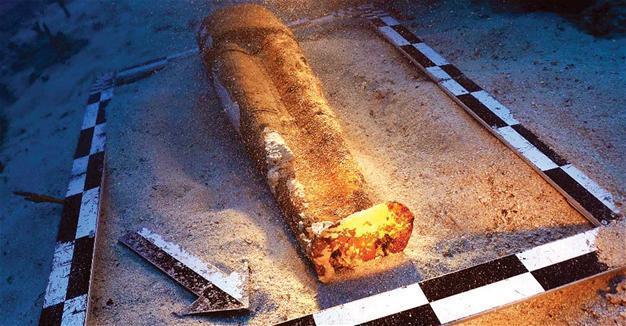Goddess sculpture found in Aegean Sea
MUĞLA – DHA
 A ceramic sculpture, which is said to be the biggest one in the history of Turkish underwater history, has been discovered off the coast of the Bozburun neighborhood in the western province of Muğla’s Marmaris district.
A ceramic sculpture, which is said to be the biggest one in the history of Turkish underwater history, has been discovered off the coast of the Bozburun neighborhood in the western province of Muğla’s Marmaris district.The 2,700-year-old sculpture found during examinations in a ship wreckage, which was unearthed last year in November, belonged to a Cypriot goddess.
The works, carried out by Dokuz Eylül University (DEU) Marine Science and Technology Institute, unearthed the sculpture 43 meters under water, and is reported to date back to the archaic period.
The institute’s Aegean Research and Application Center (EBAMER) Deputy Director and the head of the excavations, Associate Professor Harun Özdaş, said the excavations were carried out with the permission of the Culture and Tourism Ministry and the support of the Development Ministry.
He said they only found the lower half of the ceramic sculpture along with ceramic plates and amphoras.
He added that the discoveries, which were scattered around an area of 300 square meters, would shed light on a very important part of the history of the Mediterranean.
“We found such a big terra-cotta sculpture for the first time on the coasts of our country. Current researches show that the sea was the most important means of communication among Mediterranean civilizations in the ancient ages. In addition to the researches so far, the current ones made with the use of technological tools and methods show us that not only products but also opinions and philosophy were exchanged between the civilizations. Mediterranean civilizations progressed throughout ages by leaving traces on the sea. Now, using these traces, we study the civilizations that lived on the coast of our country,” he said.
Upper part to be searched
Özdaş said they found the ceramic sculpture under piles of sand after long examinations in the wreckage.
“When we cleaned its surroundings, we saw the toes of the sculpture. It made us very excited. Then we uncovered the lower part of the body. The goddess sculpture had a dress on it. We know that such sculptures were made of two pieces. This is why we believe that the upper part of the sculpture is in the same place.
This unique artifact belongs to a bare-footed woman wearing a long dress. It most probably is a goddess. We believe its original size is 1.20 centimeters. We failed to find the upper part of the sculpture as we had to stop our searches due to weather conditions. But we plan to start excavations in the region again this year.
According to first impressions, the sculpture and the wreckage date back to the end of 7th century B.C. It most probably belongs to a Cypriot goddess,” he said.
He said the conservation work of the artifacts was being carried out in the Bodrum Underwater Archaeology Museum laboratory. “The main load of the wreckage is plates. They scatter around a large field. There are also Cypriot amphoras in the wreckage. Both these finds and the sculpture indicate that the ship was a Cypriot one. The ship, which traveled from the Mediterranean to the Aegean in the archaic era, gives us important information about the relations between Mediterranean civilizations and the Aegean region,” he added.
















